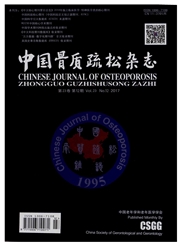

 中文摘要:
中文摘要:
目的调查藏族大学生的跟骨骨强度指数,获得该人群骨强度指数随性别及年龄的变化特点。同时分析藏族大学生骨强度指数及其与体成分之间的关系,为该群体骨质疏松的预防和干预提供参考依据。方法采用超声骨密度仪及生物电阻抗分析仪测量800例(男400例,女400例)藏族大学生右足跟骨骨强度指数及体成分等相关指标,采用Pearson相关分析法研究骨强度指数与体成分各指标之间的关系。结果 (1)藏族大学生骨强度指数曲线的一般变化特点为从21岁组起随年龄的增加先升高后降低,且男生各年龄组骨强度指数值均大于女性;(2)藏族男生骨强度指数最大值出现在22岁组,藏族女生骨强度指数最大值出现在20岁组;(3)与其他民族、地区大学生群体比较得知,藏族大学生骨强度指数较高;(4)藏族大学生各项体成分指标与骨强度指数之间均无相关性。结论藏族大学生骨强度指数较高,骨质状况良好。
 英文摘要:
英文摘要:
Objective To study the characteristic changes of calcaneus bone strength index(SI) with sex and age in Tibetan university students,to analyze the relationship between SI and body composition(BC),and to provide reference data for the prevention and diagnosis of osteoporosis(OP) in this population. Methods Ultrasonic bone densitometer and Bioelectric impedance technique were used to test the bone strength index of right calcaneus and body composition in a sample of 800 Tibetan university students(400 males,400 females). The association between bone strength index and body composition was tested by Pearson correlation analysis. Results(1) The prevalence rate of bone strength index firstly increased then decreased with age from 21 years old,and the SI of males were higher than that of females in each same age group.(2) The peak of SI occurred at 22 years in males and 20 years in females.(3) Compared with university students of other nationalities and regions,the mean values of SI were higher in Tibetan university students.(4) There were no significant correlations between indexes of body composition and SI. Conclusion The SI was high and the sclerotin situation was fine in Tibetan university students
 同期刊论文项目
同期刊论文项目
 同项目期刊论文
同项目期刊论文
 期刊信息
期刊信息
